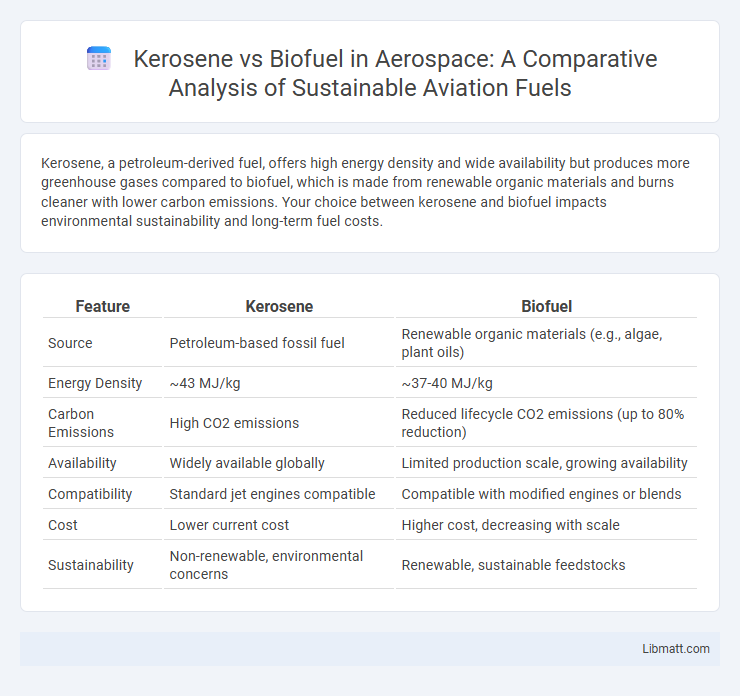Kerosene, a petroleum-derived fuel, offers high energy density and wide availability but produces more greenhouse gases compared to biofuel, which is made from renewable organic materials and burns cleaner with lower carbon emissions. Your choice between kerosene and biofuel impacts environmental sustainability and long-term fuel costs.
Table of Comparison
| Feature | Kerosene | Biofuel |
|---|---|---|
| Source | Petroleum-based fossil fuel | Renewable organic materials (e.g., algae, plant oils) |
| Energy Density | ~43 MJ/kg | ~37-40 MJ/kg |
| Carbon Emissions | High CO2 emissions | Reduced lifecycle CO2 emissions (up to 80% reduction) |
| Availability | Widely available globally | Limited production scale, growing availability |
| Compatibility | Standard jet engines compatible | Compatible with modified engines or blends |
| Cost | Lower current cost | Higher cost, decreasing with scale |
| Sustainability | Non-renewable, environmental concerns | Renewable, sustainable feedstocks |
Introduction to Kerosene and Biofuel
Kerosene is a refined petroleum product commonly used as jet fuel and for heating, known for its high energy density and widespread availability. Biofuel, derived from renewable organic materials such as plant oils and animal fats, offers a sustainable alternative with lower carbon emissions. Understanding the differences between these fuels can help you make informed choices about energy sources and environmental impact.
Historical Background of Kerosene and Biofuel
Kerosene, developed in the mid-19th century as a byproduct of petroleum refining, revolutionized lighting and heating during the industrial era, cementing its role as a primary fuel source. Biofuel, tracing its origins to early civilizations using fermented plant materials, gained modern prominence with advancements in biotechnology and growing environmental concerns. Understanding the historical evolution of these fuels helps you appreciate their distinct roles in energy consumption and sustainability efforts.
Chemical Composition and Production Methods
Kerosene is a hydrocarbon fuel primarily composed of alkanes and cycloalkanes, produced through the distillation of crude oil refining. Biofuel consists of organic compounds like fatty acid methyl esters derived from biomass feedstocks such as vegetable oils and animal fats through processes like transesterification. Your choice between kerosene and biofuel impacts emissions, sustainability, and compatibility with existing engines due to their distinct chemical compositions and production methods.
Environmental Impact and Carbon Emissions
Kerosene combustion releases significant greenhouse gases, contributing to air pollution and climate change due to its fossil fuel origin and high carbon intensity. Biofuel, derived from renewable organic materials, typically emits lower net carbon dioxide as plants absorb CO2 during growth, offsetting emissions when burned. The environmental impact of biofuel is generally reduced compared to kerosene, though factors like land use and production methods can influence its sustainability.
Energy Efficiency and Performance Comparison
Kerosene offers higher energy density, delivering consistent and reliable power for aviation and heating applications, while biofuels typically contain lower energy content but provide cleaner combustion and reduced emissions. Biofuels' performance depends on feedstock type and production method, with advanced biofuels narrowing the efficiency gap through improved combustion properties and engine compatibility. Your choice between kerosene and biofuel affects overall energy efficiency, environmental impact, and operational costs, making it crucial to balance performance needs with sustainability goals.
Cost Analysis and Market Availability
Kerosene remains widely available and cost-effective for heating and lighting, supported by established global supply chains and infrastructure. Biofuel prices tend to fluctuate due to feedstock variability, production scale, and government subsidies, often making them more expensive than kerosene in many markets. Market availability of biofuels is expanding rapidly in regions prioritizing renewable energy, while kerosene dominates in areas with less developed biofuel infrastructure.
Applications in Transportation and Industry
Kerosene remains a widely used fuel in aviation and heavy machinery due to its high energy density and stability under extreme conditions. Biofuel, derived from renewable sources such as plant oils and animal fats, is gaining traction as a sustainable alternative for transportation fleets and industrial boilers, reducing carbon emissions significantly. Your choice between kerosene and biofuel impacts operational efficiency and environmental footprint in sectors reliant on reliable, high-performance fuels.
Challenges in Adoption and Scalability
Kerosene faces significant challenges in adoption due to its environmental impact and regulatory restrictions aimed at reducing carbon emissions. Biofuel scalability is hindered by feedstock availability, land use competition, and high production costs that limit widespread implementation. Both fuels require advancements in technology and infrastructure investment to overcome supply chain constraints and achieve large-scale deployment.
Regulatory Policies and Future Trends
Regulatory policies increasingly favor biofuel adoption, with governments implementing mandates and subsidies to reduce carbon emissions and promote renewable energy sources. Stringent emissions standards and carbon pricing incentivize the shift from kerosene to sustainable biofuels in aviation and heating sectors. Future trends indicate accelerated biofuel innovation, scaling production technologies, and integration into existing fuel infrastructure, driving a transition toward lower environmental impact.
Conclusion: Choosing Between Kerosene and Biofuel
Choosing between kerosene and biofuel depends on balancing energy efficiency with environmental impact; kerosene offers high energy density but releases significant greenhouse gases, while biofuel provides a renewable alternative with lower carbon emissions. Your decision should consider the specific application, availability, and long-term sustainability goals. Emphasizing biofuel supports reducing global carbon footprints despite potential trade-offs in energy output.
kerosene vs biofuel Infographic

 libmatt.com
libmatt.com